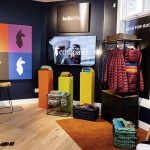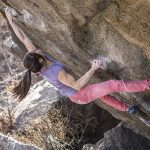Over the past few years, the womens specific market has been a driving force for much of the outdoor industry. On the Vendor side, companies like K2, Moving Comfort, Isis, and Sherpani all invested heavily in marketing and product development. According to Outdoor Industry Foundations most recent Outdoor Recreation Participation Study, over the past seven years, female participation in outdoor activities has increased to 59% of the U.S. population, compared to 53% in 1998. While the womens specific market is certainly here to stay, and will likely remain a mainstay in the outdoor industry, participation growth rates are leveling off. In-turn, a new demographic is emerging as a rapid growth category one that has some very positive, long-term potential for the industry the youth market.
In many respects, womens specific sales and products evolved into an individual industry within the outdoor market. The increased participation in outdoor activities by women boosted sales of womens specific products, which in turn has motivated many companies to invest more resources into RD&D for this market. This investment completed a chain, which became self-sustaining as marketing dollars and more intelligent design began to spur even greater participation among women.
This sharp increase in participation and the corresponding increase in sales caused the outdoor retail floor to evolve into a very different animal than it once was. More floor space is now dedicated to womens specific product, and more products are offered to the market every year. Outdoor Industry Foundation, the non-profit arm of OIA, published its seventh annual participation report which illustrates the emergence of the female outdoor customer, and now shows the potential of the newly-emerged youth market.
For the purposes of this report, a participant is defined as someone who tried an outdoor activity at least once during the past year, while an enthusiast is defined differently for each individual activity, depending on the average number of times all participants actually participate.
While these participation trends have been fueling a good portion of the growth in the outdoor industry for the past few years, the rapid increases in the womens specific category may be leveling off. The participant base remains very healthy, with over 16% of the U.S. female population falling into the enthusiast category.
The evidence of a slow-down comes in the short term analysis. Comparing 2004 to the previous year, the only category to show significant growth among women is fly fishing, while all others remained relatively flat.
Perhaps one sign that points to further continued health in the womens specific category is the increase in female outdoor enthusiasts among some very specific activities. Last year, OIA commissioned Harris interactive to complete a study of the outdoor consumer market, which identified three key “gateway” activities hiking, biking, and camping. Female enthusiast activity has increased dramatically in four major categories, three of which fall under these gateway activities. Car camping jumped 72% among women since 1998 and paved road bicycling increased 43% while single track bicycling and snowshoeing both doubled. The fact that there has been such substantial growth in enthusiast participation in gateway activities is certainly a positive sign for growth in other, more specialized categories.
This slow down of growth in the womens category has a second silver lining. Demographic trends among participants show a considerable increase in youth participation among women. In fact this increase is occurring in youth participation for both sexes. Among the 16-24 year-old age group defining the youth population, 81% tried an outdoor activity at least once in 2004. This compares to 78% in 1998. Enthusiast participation growth is even more profound, increasing to 30% in 2004 compared to 25% in 1998.
Short term trends show that this growth is actually accelerating in spite of increased competition coming from various forms of virtual and electronic entertainment. While general participation levels were unchanged year-on-year, enthusiast levels increased dramatically. 2003 participation levels estimate that there were 10.8 million human-powered outdoor recreation enthusiasts in the 16-24 age group. This most recent report estimates that there are 13.4 million enthusiasts, representing an increase of 25%. This is on top of a 17% increase in enthusiast levels from 2002 to 2003.
Within the demographic data in the youth age-group, there are some encouraging signs as well. Efforts within the outdoor industry to appeal to a more ethnically diverse audience appear to be paying-off. In 1998, 74% of the participants in the 16-24 year-old age group were Caucasian. That number reached its peak the following year at 79%. This most recent report shows that the percentage has been consistently declining as participation among other ethnic groups, particularly African-Americans and Hispanic-Americans, is consistently increasing. In this seventh edition report, OIF has found that 66% of the youth outdoor recreation participants are Caucasian, 11% are African-American, and 11% are Hispanic. These numbers still do not reflect the overall population distribution, but it is a step in the right direction.
Looking at these two opportunities the youth market and the womens specific market – there certainly is reason to be optimistic. For several years, the outdoor industry has been looking for ways to become more relevant to the youth demographic, and it seems that these efforts are beginning to show results. Several retailers, most notably EMS, are re-vamping their stores to be more meaningful to this market, which is just beginning to show interest.
Likewise, the womens specific market will continue to grow as more participants in gateway activities are converted to participants in other outdoor sports. With the solid product, merchandising, and marketing infrastructure already in place in the outdoor industry, many retailers and vendors are poised to take advantage of the future growth in this category. Preparing the industry to change its view of the youth culture and teaching both retailers and vendors a new vocabulary to make communicating to this demographic more effective will be the next challenge.















